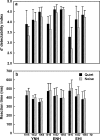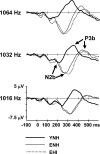Effects of age, age-related hearing loss, and contralateral cafeteria noise on the discrimination of small frequency changes: psychoacoustic and electrophysiological measures
- PMID: 16027962
- PMCID: PMC2504594
- DOI: 10.1007/s10162-005-5029-6
Effects of age, age-related hearing loss, and contralateral cafeteria noise on the discrimination of small frequency changes: psychoacoustic and electrophysiological measures
Abstract
The aim of the study was to examine central auditory processes compromised by age, age-related hearing loss, and the presentation of a distracting cafeteria noise using auditory event-related potentials (ERPs). In addition, the relation of ERPs to behavioral measures of discrimination was investigated. Three groups of subjects participated: young normal hearing, elderly subjects with normal hearing for their age, and elderly hearing-impaired subjects. Psychoacoustic frequency discrimination thresholds for a 1000-Hz pure tone were determined in quiet and in the presence of a contralateral cafeteria noise. To elicit ERPs, small frequency contrasts were presented with and without noise under unattended and attended conditions. In the attended condition, behavioral measures of d' detectability and reaction times were also obtained. Noise affected all measures of behavioral frequency discrimination significantly. Except N1, all ERP components in the standard and difference waveforms decreased significantly in amplitude and increased in latency to the same degree in all three subject groups, arguing against a specific age-related sensitivity to the effects of contralateral background noise. For N1 amplitude, the effect of noise was different in the three subject groups, with a complex interaction of age, hearing loss, and attention. Behavioral frequency discrimination was not affected by age but deteriorated significantly in the elderly subjects with hearing loss. In the electrophysiological test, age-related changes occurred at various levels. The most prominent finding in the response to the standard stimuli was a sustained negativity (N2) following P2 in the young subjects that was absent in the elderly, possibly indicating a deficit in the inhibition of irrelevant information processing. In the attended difference waveform, significantly larger N2b and smaller P3b amplitudes and longer N2b and P3b latencies were observed in the elderly indicating different processing strategies. The pronounced age-related changes in the later cognitive components suggest that the discrimination of difficult contrasts, although behaviorally maintained, becomes more effortful in the elderly.
Figures












References
-
- {'text': '', 'ref_index': 1, 'ids': [{'type': 'DOI', 'value': '10.1037/0882-7974.14.3.507', 'is_inner': False, 'url': 'https://doi.org/10.1037/0882-7974.14.3.507'}, {'type': 'PubMed', 'value': '10509703', 'is_inner': True, 'url': 'https://pubmed.ncbi.nlm.nih.gov/10509703/'}]}
- Alain C, Woods DL. Age-related changes in processing auditory stimuli during visual attention: evidence for deficits in inhibitory contol and sensory memory. Psychol. Aging 14:507–519,1999. - PubMed
-
- {'text': '', 'ref_index': 1, 'ids': [{'type': 'DOI', 'value': '10.1016/S0168-5597(98)00007-0', 'is_inner': False, 'url': 'https://doi.org/10.1016/s0168-5597(98)00007-0'}, {'type': 'PubMed', 'value': '9714378', 'is_inner': True, 'url': 'https://pubmed.ncbi.nlm.nih.gov/9714378/'}]}
- Amenedo E, Diaz F. Automatic and effortful processes in auditory memory reflected by event-related potentials. Age-related findings. Electroencephalogr. Clin. Neurophysiol. 108:361–369, 1998a. - PubMed
-
- {'text': '', 'ref_index': 1, 'ids': [{'type': 'DOI', 'value': '10.1016/S0301-0511(98)00040-4', 'is_inner': False, 'url': 'https://doi.org/10.1016/s0301-0511(98)00040-4'}, {'type': 'PubMed', 'value': '9788763', 'is_inner': True, 'url': 'https://pubmed.ncbi.nlm.nih.gov/9788763/'}]}
- Amenedo E, Diaz F. Aging-related changes in processing of non-target and target stimuli during an auditory odd ball task. Biol. Psychol. 48:235–267, 1998b. - PubMed
-
- {'text': '', 'ref_index': 1, 'ids': [{'type': 'DOI', 'value': '10.1016/S0013-4694(96)96518-9', 'is_inner': False, 'url': 'https://doi.org/10.1016/s0013-4694(96)96518-9'}, {'type': 'PubMed', 'value': '9020805', 'is_inner': True, 'url': 'https://pubmed.ncbi.nlm.nih.gov/9020805/'}]}
- Anderer P, Semlitsch HV, Saletu B. Multichannel auditory event-related brain potentials: effects of normal aging on the scalp distribution of N1, P2, N2 and P300 latencies and amplitudes. Electroencephalogr. Clin. Neurophysiol. 99:458–472, 1996. - PubMed
-
- {'text': '', 'ref_index': 1, 'ids': [{'type': 'DOI', 'value': '10.1037/0882-7974.5.4.597', 'is_inner': False, 'url': 'https://doi.org/10.1037/0882-7974.5.4.597'}, {'type': 'PubMed', 'value': '2278686', 'is_inner': True, 'url': 'https://pubmed.ncbi.nlm.nih.gov/2278686/'}]}
- Barr RA, Giambra LM. Age-related decrement in auditory selective attention. Psychol. Aging 5:597–599, 1990. - PubMed
Publication types
MeSH terms
LinkOut - more resources
Full Text Sources
Medical

